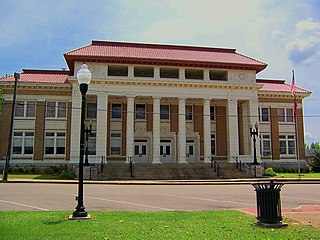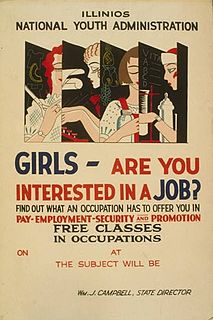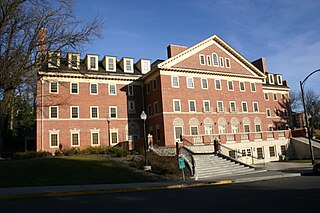
The Household Service Demonstration Project (HSDP) was a Works Progress Administration (WPA) project designed to train women for domestic employment. [1]

The Household Service Demonstration Project (HSDP) was a Works Progress Administration (WPA) project designed to train women for domestic employment. [1]
The project was an offshoot of the Household Workers’ Training Program. The WPA announced the project in March 1937. [2] It got under way around July 1937 [3] and ended it in January 1942. [4] The project was formally authorized by United States Congress in 1938. It offered training and employment in WPA training centers [5] giving demonstrations of housework. [6] The WPA designed it to promote the employment of women certified as qualified for private household employment and to promote the techniques of household service. [7]
The project trained 30,000 women. [8] Middle-aged women were preferred due to the perceived unreliability and increased risk of marriage of younger women. [9] The project employed 1,700 women to give two- and three-month courses in cooking and serving food, house and child care, washing, ironing, and marketing. [10] Other skills taught included table setting, [9] home management, budgeting and knitting. [9]
In Washington, during the course of their training, trainees were paid $46 a month. After passing written and oral exams, diplomas were awarded to graduates. [11] After completing training, a graduate could make $60 a month as a domestic. [9]
Demonstration sites were located at 400 South Capitol Street in Washington, DC, [12] and at 217 E Boone Ave in Spokane, Washington.
The HSDP was called Eleanor Roosevelt’s favorite project. [13] It was part of the WPA’s traditional emphasis. [14] The assistant state supervisor of seven household service projects in Pennsylvania was reported as saying, "There is something so obvious about a woman working in a home that I wonder why a project such as this wasn't begun many years ago."

Public Works Administration (PWA), part of the New Deal of 1933, was a large-scale public works construction agency in the United States headed by Secretary of the Interior Harold L. Ickes. It was created by the National Industrial Recovery Act in June 1933 in response to the Great Depression. It built large-scale public works such as dams, bridges, hospitals, and schools. Its goals were to spend $3.3 billion in the first year, and $6 billion in all, to supply employment, stabilize buying power, and help revive the economy. Most of the spending came in two waves in 1933–35, and again in 1938. Originally called the Federal Emergency Administration of Public Works, it was renamed the Public Works Administration in 1935 and shut down in 1944.

The Works Progress Administration was an American New Deal agency, employing millions of jobseekers to carry out public works projects, including the construction of public buildings and roads. It was set up on May 6, 1935, by presidential order, as a key part of the Second New Deal.

Pontotoc is a city in, and the county seat of, Pontotoc County, Mississippi, located to the west of the much larger city of Tupelo. The population was 5,625 at the 2010 census. Pontotoc is a Chickasaw word that means, “Land of the Hanging Grapes.”

Pullman is the largest city in Whitman County, located in southeastern Washington state within the Palouse region of the Pacific Northwest. The population was 29,799 at the 2010 census, and estimated to be 34,506 in 2019. Originally founded as Three Forks, the city was renamed after industrialist George Pullman in 1884.

Washington State University is a public land-grant research university with its flagship, and oldest, campus in Pullman, Washington. Founded in 1890, WSU is also one of the oldest land-grant universities in the American West. With an undergraduate enrollment of 24,278 and a total enrollment of 28,581, it is the second largest institution for higher education in Washington state behind the University of Washington. It is classified among "R1: Doctoral Universities – Very high research activity".

Wichita State University (WSU) is a public research university in Wichita, Kansas, United States. It is governed by the Kansas Board of Regents. The university offers more than 60 undergraduate degree programs in more than 200 areas of study in six colleges. The university's graduate school offers 44 master's degrees in more than 100 areas and a specialist in education degree. It is classified among "R2: Doctoral Universities – High research activity".
The Federal Art Project (1935–1943) was a New Deal program to fund the visual arts in the United States. Under national director Holger Cahill, it was one of five Federal Project Number One projects sponsored by the Works Progress Administration (WPA), and the largest of the New Deal art projects. It was created not as a cultural activity, but as a relief measure to employ artists and artisans to create murals, easel paintings, sculpture, graphic art, posters, photography, theatre scenic design, and arts and crafts. The WPA Federal Art Project established more than 100 community art centers throughout the country, researched and documented American design, commissioned a significant body of public art without restriction to content or subject matter, and sustained some 10,000 artists and craft workers during the Great Depression.

A domestic worker is a person who works within the scope of a residence. The term "domestic service" applies to the equivalent occupational category. In traditional English contexts, such a person was said to be "in service". Domestic workers perform a variety of household services for an individual(s), from providing cleaning and household maintenance, or cooking, laundry and ironing, or care for children and elderly dependents, and other household errands.
Euthenics is the study of improvement of human functioning and well-being by improvement of living conditions. "Improvement" is conducted by altering external factors such as education and the controllable environments, including the prevention and removal of contagious disease and parasites, environmentalism, education regarding employment, home economics, sanitation, and housing.

The National Youth Administration (NYA) was a New Deal agency sponsored by Franklin D. Roosevelt during his presidency. It focused on providing work and education for Americans between the ages of 16 and 25. It operated from June 26, 1935 to 1939 as part of the Works Progress Administration (WPA) and included a Division of Negro Affairs headed by Mary McLeod Bethune who worked at the agency from 1936 to 1943. Following the passage of the Reorganization Act of 1939, the NYA was transferred from the WPA to the Federal Security Agency. In 1942, the NYA was transferred to the War Manpower Commission (WMC). The NYA was discontinued in 1943.

Homer Adams Holt was a West Virginia lawyer and politician who served as that state's 20th governor from 1937 to 1941. Born in Lewisburg, West Virginia, he attended the Greenbrier Military School there and then went on to graduate from Washington and Lee University in 1918, where he was a member of the Phi Kappa Psi fraternity. After serving in the army during World War I, he returned to Washington and Lee in 1920 and studied law, receiving his degree in 1923. In 1924, he married Isabel Wood.

The Battle of the Palouse refers to an athletic rivalry in the northwest United States, between the Vandals of the University of Idaho and Cougars of Washington State University.
Domestic violence in Chile is a prevalent problem as of 2004. Domestic violence describes violence by an intimate partner or other family members, regardless of the place the violence occurs.

Georgette Seabrooke, was an American muralist, artist, illustrator, art therapist, non-profit chief executive and educator. She is best known for her 1936 mural, Recreation in Harlem at Harlem Hospital in New York City, which was restored and put on public display in 2012 after being hidden from view for many years.

We Work Again is a 1937 ephemeral film produced by the Work Projects Administration to promote its employment and training efforts for African-Americans during the Great Depression. Various jobs are shown, including public construction projects, domestic service and health care training, adult education programs and performing arts. It is particularly noted for containing the only existing footage of the 1936 Federal Theatre Project production of Macbeth, directed by Orson Welles and featuring an all-black cast.
William LeRoy "Roy" LaFollette Jr. (1890–1950) was an American political figure and lawyer. He served in the Washington House of Representatives in the State Legislature. He was elected Prosecuting Attorney of Whitman County several times. He was appointed by President Franklin Roosevelt to the Washington State Public Works Commission.

The Pack Horse Library Project was a Works Progress Administration (WPA) program that delivered books to remote regions in the Appalachian Mountains between 1935 and 1943. Women were very involved in the project which eventually had 30 different libraries serving 100,000 people. Pack horse librarians were known by many different names including "book women," "book ladies," and "packsaddle librarians." The project helped employ around 200 people and reached around 100,000 residents in rural Kentucky.
Washington State University Everett is a campus of Washington State University in Everett, Washington. The land-grant research university was founded in 1890 and the Washington State Legislature approved funding for WSU to expand to Snohomish County in 2011. The campus began with a 95,000-square foot building costing $64 million. The campus was founded in 2014, and courses began in the Fall of 2017.
This is a Timeline of second-wave feminism, from its beginning in the mid-twentieth century, to the start of Third-wave feminism in the early 1990s.

The Elmina White Honors Hall, also known as Honors Hall is a residence hall located on the main campus of Washington State University in Pullman, Washington. It was designed by Stanley Smith, the head of the architecture department at Washington State University (1924-1947), and was completed in 1928. It was later remodeled into student housing and faculty offices in 2001, costing $15.3 million. It is located in the northwest corner of Washington State University (WSU) in Pullman, Washington. Its original purpose was to house the Home Economics department as part of the College of Domestic Economy. Following the 2001 reconstruction, the four-story building, with a converted basement, was transformed into three floors of residential suites with classrooms, offices, and a library for the WSU Honors College on the ground floor, and several multi-purpose rooms in the basement. It was designed in a Georgian Revival style and was referred to as an “elegant architectural statement” in a report provided by the Washington State University Task Force for Historic Preservation in 1985.